List of Authors
>>About this blog
Recent blog post
|
[Dye]
July 29, 2016 09:00
It's almost time for the rainy season.
The other day, I introduced a cooking class in Ginza on this blog.
This time, I was able to go to the restaurant for dinner, so I'll introduce it.
The Japanese restaurant "Ginza Fujita" in Ginza 8-chome holds cooking classes during the daytime on weekdays and every Saturday, but it is an adult restaurant that is usually used for entertainment.
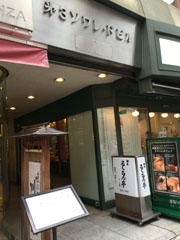 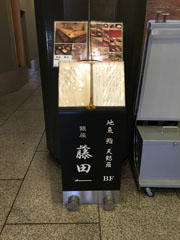
It is on the first basement floor of the Third Soire de Bill, along with Hakuhinkan.
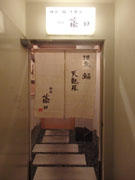
Ginza store...I'm a little nervous, but let's get in by the light.☆
The counter was open, so I watched the general make it vividly in front of me.
I'll wait with excitement.
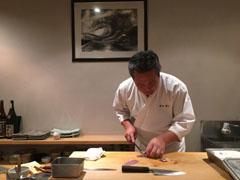
The general's story is also fun, and you  can feel comfortable hospitality. can feel comfortable hospitality.
He seems to have been playing baseball in earnest when he was a student, so you may be able to listen to such a story.
At the right time, elaborate dishes are brought in front of you one by one.
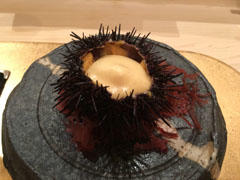 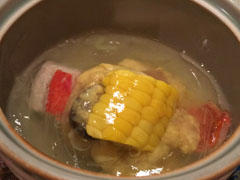
"Urchins" that are still fresh enough to move and "steamed food" with many ingredients.
When you hold sushi, you use large leaves only for scenting (! ! Yes, it's a casual one-handed.
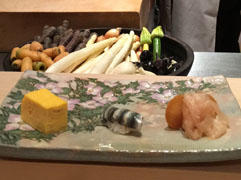
This vegetable is tempura.
Everything grows normally, but it seems that it is harvested while it is small.
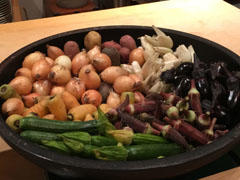
"Ebisen" with fragrant and rich flavor and "Egg rice" with fried rice. Super delicious!
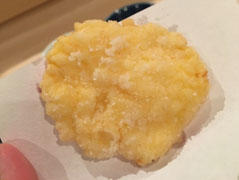 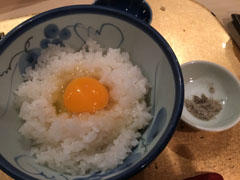
In addition, Howahowa's anago, aoriika with a faint yuzu scent, and a thick and pleuri shrimp...etc
There were various things, but there was no photo because I ate it unintentionally when it was served (^^;
It is a shop that seems to be so fun and happy to eat (' ▽ `*)
It seems that there are people from overseas, but it is perfect to convey the splendor of Japanese food.
It's also recommended for the best meal here.☆
== Cooking classes that can be learned here are also being recruited from time to time ==
☆Related blog☆
About beginner class
About intermediate class
◆Ginza Fujita
HP: http://hitosara.com/0006039581/ (Hito Sarah)
Address: 8-8-7 Ginza, Chuo-ku Third Soire de Bill B1F
Phone: 03-3572-5601
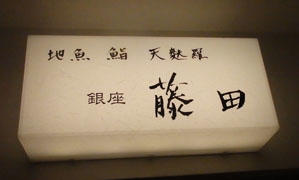
[CAM]
July 28, 2016 18:00
In my last blog, I wrote that I didn't know the description that Kafu went to Takebatei, and I was a little worried and read "Shokutei Nijo". Then, several places, the name "Takebatei" appears.
(September 15, 1935) "It's a dark day. The time is the day. Around 4:00 pm today) I went to the Nihonbashi Shirakiya Tower used book exhibition and went to Owaricho Takebatei. "
(December 15, 1935) "I went to cogure Ginza and went to Owaricho Takebatei and visited the Gochaya Beru (Cuber)".
(October 5, 1937) "It's cloudy and hot. I don't think it's the climate of October. I got up at noon and went to Ginza to Tosa Bridge. ・・ ・ ・ ・ I will go to Ginza again at night and eat at Takebatei."
In addition, it is a description of eating eel.
(December 28, 1917) "I invite a contributor to Yone-do master 'civilization' to eel shop Miyakawa in front of Fukagawa Hachiman. I'll be invited to give up for the disease."
(May 28, 1921) "Invited by Matsumuko and drink to Nakadori's eel shop Komatsu."
(June 1947, 8) "It's like a bran all day long. At the market in front of Ichikawa Station, eat 90 yen eel rice and go to the sea god. "
However, as a whole, there are very few descriptions. It seems that eel was not very good for the cargo wind.
(Early 8, 1940), "Eels who educate their children must first be aware of the subtleties of these human minds," said, "Eels are not exhausted (all things) It's a big fall. "
[Shiba Inu]
July 28, 2016 14:00
On Sunday, July 24th, we washed Nihonbashi Bridge!
If you look at this, I feel that it's finally a summer performance.
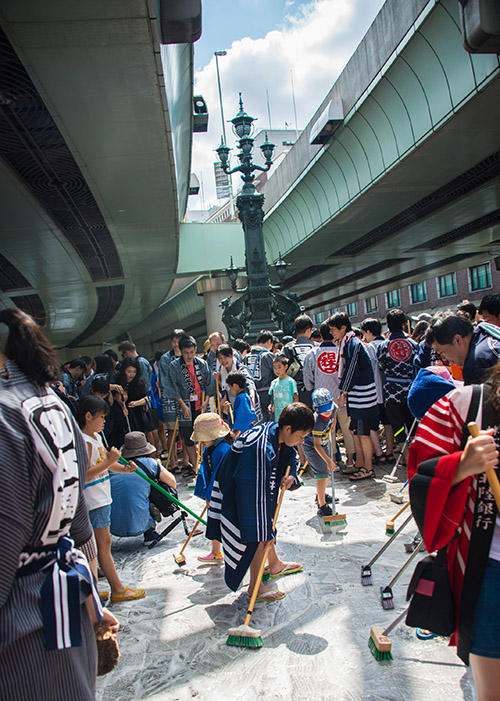
"Nihonbashi Washing" is hosted by [Naibashi Nihonbashi Preservation Society] and is held on the fourth Sunday of July every year. Neighborhood associations, fire departments, neighboring companies, etc. participate freely and clean Nihonbashi with a festive atmosphere. Participation is required by pre-registration. If you are interested, please contact us at Nihonbashi Preservation Society!
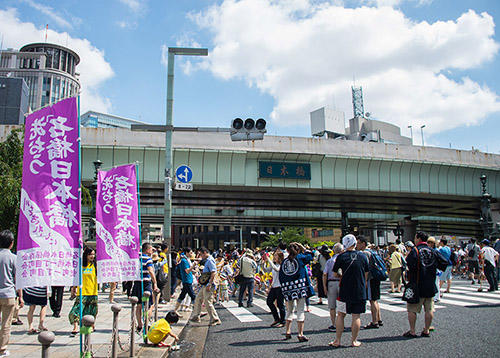
The day is from morning to summer. It's already full of people at nine a.m. Until noon, we will have you stop the nearby road and clean it together.
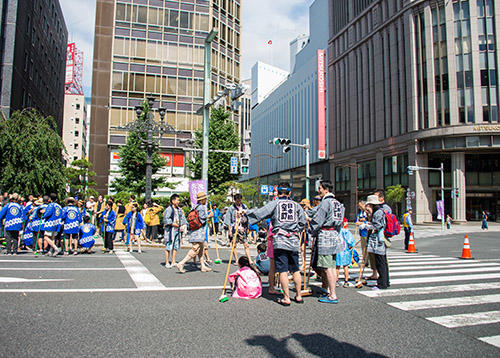
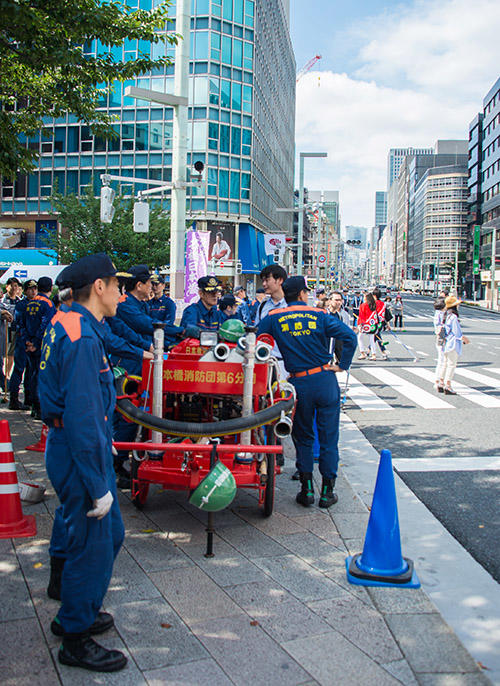
The fire department is also ready. It's cool! The children were flocking.
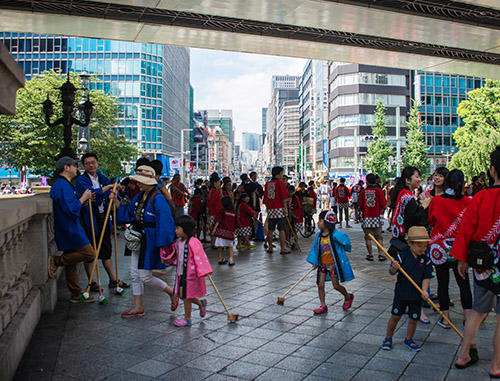
Well, first of all, from the ceremony.
"Japan Road Sign" in the middle of Nihonbashi Road, which you can't usually see (there is a reproduction in the square of Nihonbashi Kitazume!) And water from all over the world.
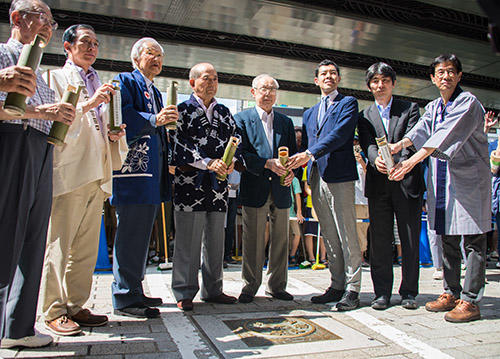 
It's cool. Yes! His figure, too...。↑
After the ceremony is completed successfully, a water truck will appear. This year, we are using reclaimed water. So the hydropower is weaker than usual.
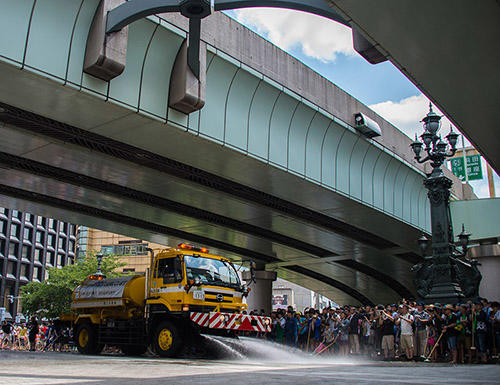
Well, I will do my best with human power!
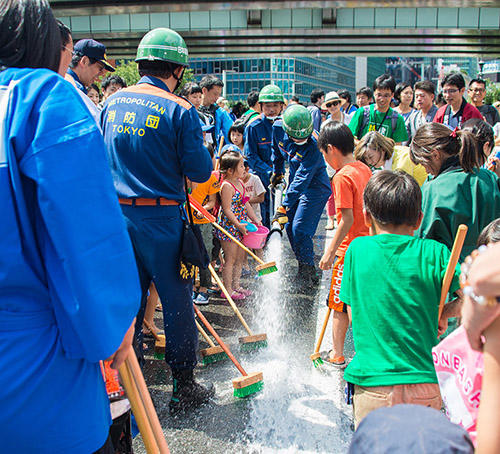
It looks like playing in the water. If the Nihonbashi River becomes a beautiful waterside, will these sights be seen on a daily basis?
And what's Starbucks across the bridge!
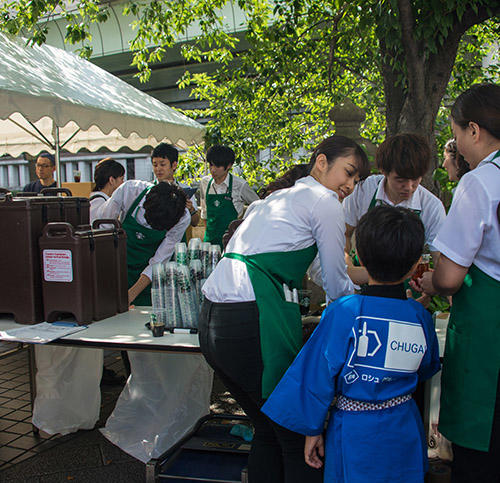
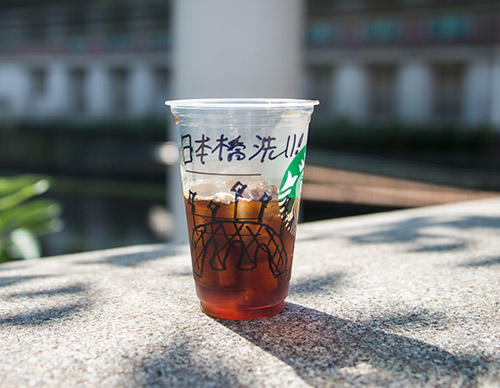
I've served iced coffee.
A lot of milk and sugar are also available so that even those who are not good at coffee or children can drink it. He served with a smile in the scorching sun. Thank you very much.
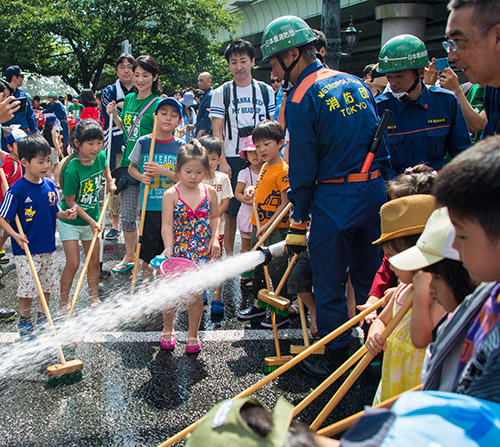
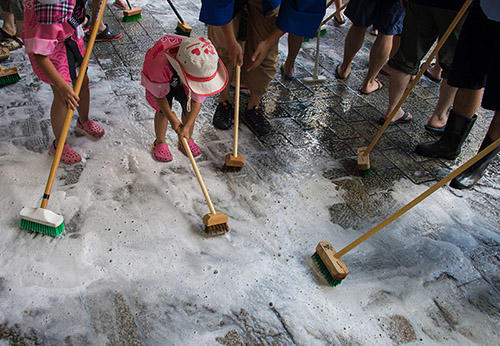
One hour has passed since the start. Nihonbashi is already Awaa. By this time, those who participated in plain clothes gently evacuated to the sidewalk. Rubber sandals and shorts are required if you want to wash them thoroughly!
Speaking of clothes, people from nearby companies participating in Nihonbashi Bridge Washing...My name is happi coat.
You can see happi coat, a variety of long-established companies that you can't usually see, as well as happi coat Mania. All of them are devised to express the corporate culture, and it's fun just to look at them.
 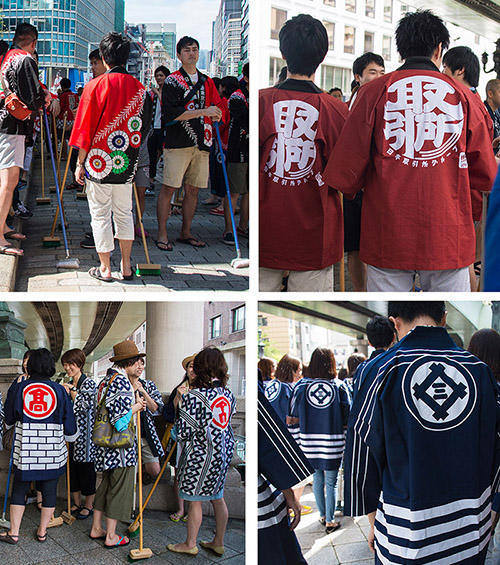 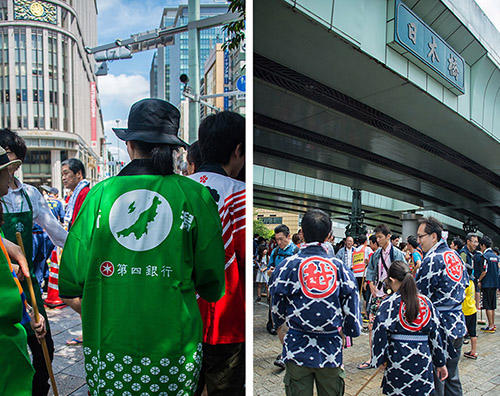
By the way, companies say that even if they participate today, they will not go to work on holidays (laughs).
As various people participate and clean and clean, even strangers can somehow get acquainted with each other. Please come and see such a bridge wash and everyone! Nihonbashi early in the morning is also interesting!
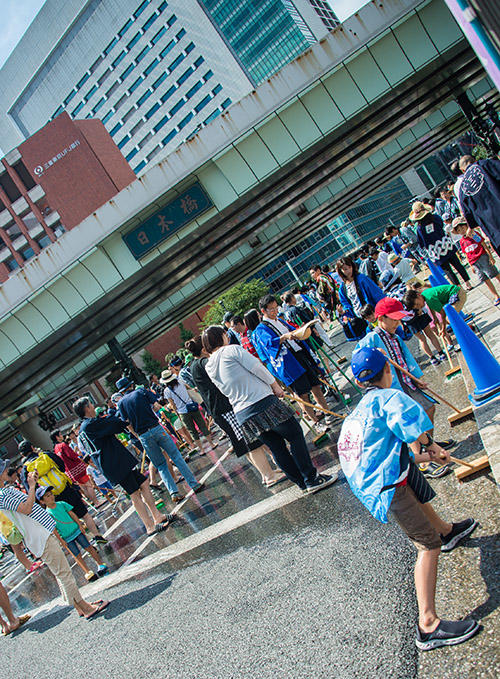 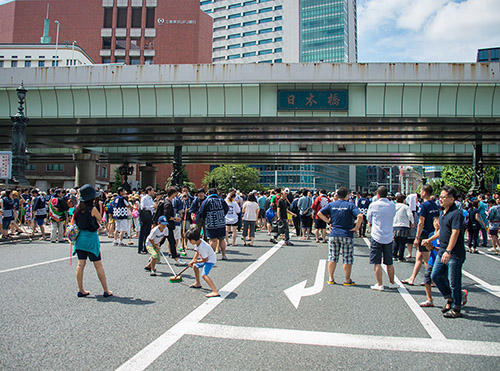
Finally, Chuo-ku is also in summer.
Everyone, please come and visit us!
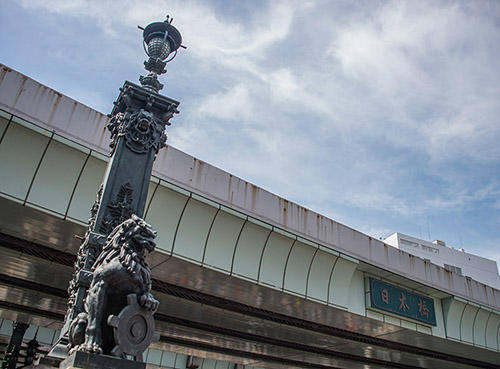
Is it beautiful?
[The Rabbit of Tsukuda]
July 28, 2016 12:00
At 6 o'clock the morning, unfamiliar voices from somewhere on the Sumida River Terrace of Ishikawajima Park are echoing.
If you look closely, you can see a black silhouette near the center of the river surface.
It's bigger and plump than Mr. Kawau, what is it?
Even if you use the telephoto of the camera in the backlight of the morning sun, you will not be able to determine its identity.
Fortunately, we are gradually approaching the flow of the Sumida River.
If you reach a certain distance here, you will return to the middle of the river again.
After such a repetition several times, what is their identity captured by the camera!
Four young birds from black-tailed gull.
The silhouette of the beak clearly seen when facing sideways is exactly that of black-tailed gull.
But is the color and pattern of the wings covering the body discovered a new species? It's different from adult bird, which is just mistaken.
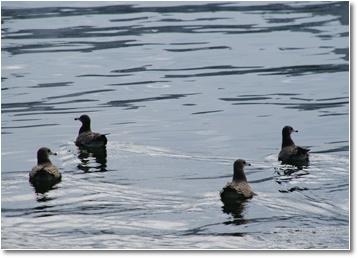
black-tailed gull often picks fish that serve food at fishing ports.
It is an image of flying in groups near the fishing port.
(As an aside, seagull is migratory bird and a winter bird, so it is not in summer.
All birds like seagull that we witness in the summer are seabirds.)
As you all know, it sounds like a mecher and a cat.
In kanji, it is described as a sea cat, but the English name is Black tailed gull because it has a black belt on the white tail.
Here's adult bird.
Mrs. black-tailed gull and others as you imagine.
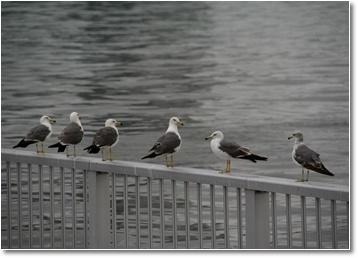
Well, where did these young birds come from?
Is it from a breeding ground along the Kanto region? I'm not sure.
black-tailed gull is one of the world's largest cities in Japan.
Sakhalin, Chishima Islands, Mainland China Coast to Taiwan.
It is a rare bird in the world
Five breeding grounds in Japan, including Kabushima Island in Aomori Prefecture and Tsubaki Island in Iwate Prefecture, are designated as natural monuments.
Only those that hatched in breeding grounds and grew from young bird to young birds appear in each fishing port in summer.
black-tailed gull seems to have a very high sense of territory, and the parent bird attacks another chick approaching the nest.
The chicks also get wounds until they die.
The young bird who came to this Sumida River was
It seems to be elite in the elite that has survived for about two months since hatching.
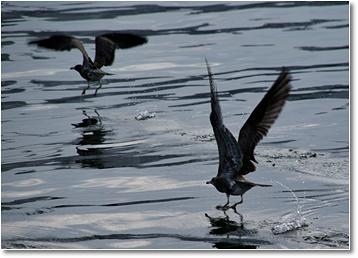
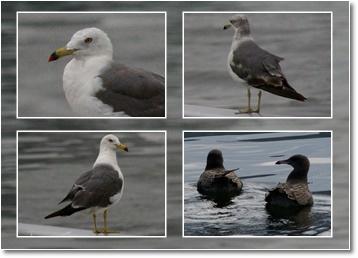
black-tailed gull takes three years to breed from young bird to adult bird.
It seems that it can be identified for several years from that feather.
Mr. black-tailed gull in the upper right of the photo above is still gray and some of his wings are brown.
It can be seen like the second year.
The breeding adult bird will return to the breeding ground at the end of February next year, but the young birds will winter.
It is divided into a group that can be observed all year round on the Sumida River and a group that returns to a breeding ground.
The more you know, the deeper you are, Mr. black-tailed gull.
How old are you from now on? I would like to observe it while thinking about it.
[Dharma]
July 28, 2016 09:00
 Walk along Sumida Kawamukai at Exit 6 of Shintomicho Line (2.4m above sea level) on the Yurakucho Line, and you will see the entrance of Tsukuda-ohashi Bridge (currently under seismic reinforcement work), which was bridged in 1964. There is a stone monument of Tsukuda Island ferry, which has a cute fruit tree on the shelf of the children's park near it. On the main street is the International Paper and Pulp Trading Co., Ltd., which was newly built in 2003, on the site of the Tsukiji Sanin. Let's take a look! At the entrance, the Sendai Tanabata decoration produced by a subsidiary of the company's Sendai is exhibited to the general public until August 19 Walk along Sumida Kawamukai at Exit 6 of Shintomicho Line (2.4m above sea level) on the Yurakucho Line, and you will see the entrance of Tsukuda-ohashi Bridge (currently under seismic reinforcement work), which was bridged in 1964. There is a stone monument of Tsukuda Island ferry, which has a cute fruit tree on the shelf of the children's park near it. On the main street is the International Paper and Pulp Trading Co., Ltd., which was newly built in 2003, on the site of the Tsukiji Sanin. Let's take a look! At the entrance, the Sendai Tanabata decoration produced by a subsidiary of the company's Sendai is exhibited to the general public until August 19 . By the way, this year's Sendai Tanabata is from 8/6 to 8/9. . By the way, this year's Sendai Tanabata is from 8/6 to 8/9.
 International Paper and Pulp Trading International Paper and Pulp Trading
On the right side of this building is the monument of the birthplace of "Women's Seigakuin", which was founded in 1905, and in the planting diagonally in front of the entrance, there is a monument to "Kaigan Jogakuin", which is Chu of Aoyama Gakuin.
 From here, head toward St. Luke's Tower (height: 220.63m), Shiose Sohonke, the birthplace of buns with a history of 660 years, on Idomechi Street, just before the St. Luke's Tower (height: 220.63m)....The character of "Japan's No. 1 Manjusho" raised when opening a bun shop in Kyoto. From here, head toward St. Luke's Tower (height: 220.63m), Shiose Sohonke, the birthplace of buns with a history of 660 years, on Idomechi Street, just before the St. Luke's Tower (height: 220.63m)....The character of "Japan's No. 1 Manjusho" raised when opening a bun shop in Kyoto.
According to the company profile of the Shiose Sohonke, it was founded in 1349 in Northern and Southern Courts period (1349), the year when Hayashi Jogen, who brought the first potato bun and Nara bun, came to Japan from China. The history of buns on the company's website and the Great Encyclopedia (Manju)! ! !
"Shiose Sohonke" opened in Nihonbashi from Kyoto in Manji 2 (1659). Established in Akashicho, the current location in 1950 (HP). Right now there is no coffee room on the second floor, but the inside of the store is still respectful of the formal style. Hon bun of the seventh generation of the post-war era (Hey-) and Japanese sweets "Dorayaki" and "Daifuku" are nice to the common people....I had an elegant taste of a famous store.
 Shiose Sohonke Shiose Sohonke
 In the Edo period, the town of Minato Irifune, which flourished in Edo Minato. A town where old houses and restaurants are still mixed, probably because it is a corner of a foreigner's shelter, has escaped from the damage of the war? It seems to be a district where development is delayed even in Chuo-ku. There are still many printing and related businesses, and there is the Mizuno Printing Museum at Irifune 2-chome. I remember that this area was a worm-eating state after the rise and collapse during the bubble period. At Minato 2-chome, the redevelopment of the construction of a high-rise complex is progressing here. The nearby "Tetsugunsu Inari Shrine" is under construction for the 1180th anniversary commemorative project, and the torii is closed (visiting is as usual HP). In the Edo period, the town of Minato Irifune, which flourished in Edo Minato. A town where old houses and restaurants are still mixed, probably because it is a corner of a foreigner's shelter, has escaped from the damage of the war? It seems to be a district where development is delayed even in Chuo-ku. There are still many printing and related businesses, and there is the Mizuno Printing Museum at Irifune 2-chome. I remember that this area was a worm-eating state after the rise and collapse during the bubble period. At Minato 2-chome, the redevelopment of the construction of a high-rise complex is progressing here. The nearby "Tetsugunsu Inari Shrine" is under construction for the 1180th anniversary commemorative project, and the torii is closed (visiting is as usual HP).
By the way, what is the middle of Chuo-ku? It's near Irifune 3-chome...I tried to verify it in "Chuo-ku's first story map".
The Japanese confectionery shops are Irifune 3-chome "Sanyo" near Exit 7 of Shintomicho, the birthplace of the shoe industry, and Irifune Aoyagi, 1-chome immediately from Hatchobori Station.
"Sanyo" ・・ ・ Since its establishment in 1933, it has continued to preserve the original taste of Japanese sweets without being misled by fashion....(HP)。 "Mizu Manju" is wrapped in Kumasasa, and you can enjoy a thick skin, elegant grain bean paste and aroma. Also, I would like to have Japanese sweets with a sense of season!
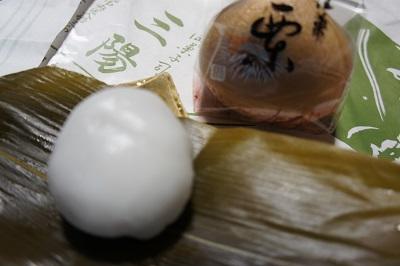 Sanyo Sanyo
"Irifune Aoyagi": Opened at the current location in October 1891 (originally Minami Hatchobori). The pendulum clock of the Meiji period is carved in the store a long-established time. "Chrysanthemumchu" inherited from the first generation is a crispy thin skin and high-quality bean paste....I'm satisfied with the recommendation! The scent of cherry blossom skin "Domyoji"! I felt Japanese sweets with polite techniques.
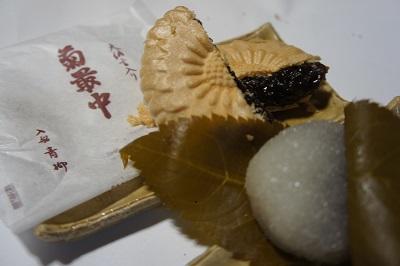 Irifune Aoyagi Irifune Aoyagi
That's all.
[CAM]
July 27, 2016 18:00
Sagigoro introduced Yasaburo Ikeda's theory that the origin of the name "Nihonbashi" was derived from "Nihonbashi", but happened to understand this negatively ("Chuo Ward Ward Walking Historic Sites and History (Part 8) ", Chuo-ku Planning Department Public Relations Section, edited and published March 2010) (hereinafter referred to as "walks in the ward"). Yasaburo Ikeda's theory was preached in "Nihonbashi Private Note" (published in 1972), and it is a work nearly 45 years ago, but "walking in the ward" is relatively recent.
"Walking in the ward" is described as follows.
>Ikeda is said to have been a bridge "Nihonbashi" that originally passed two logs. The poor bridge is probably for construction, but from the width of the Nihonbashi River, it will not be used to pass two logs. (25)
But on the other hand,
>However, it is natural that a simple bridge was built for construction at the time of landfill. It may have been about to have passed two thick logs ... (19) and said that it was contradictory.
Mr. Ikeda
>"Seeing collection" (Keicho era hearing collection; early Edo period reading) that touched on the origin of Nihonbashi Bridge name. Miura Joshin's work. Published in 1614 (Keicho era 19). I think we should read the articles before and after the 10th volume.
And so on
>According to the "Mikishu", "Edo has only a narrow flow from the old days", and although I was "five bridges", "Minna, Tana Bridge, nameless bridges", The five bridges are (1) Kishibashi, (2) One bridge, (3) Takebashi, (4) Ohashi, (5) Zenbebashi, and (5) Zenbe.
And then
>I'm interested in the description of such a "watching collection" preaching how the name of the bridge will be spontaneously completed. Hitotsubashi because it is a one-bridge of Maruki, and Takebashi because it is made of bamboo. Ohashi because it's bigger than others. It's so natural and ordinary. (53)
Also,
>The book "One Purple (Hitomoto)" states, "What happened to Hitotsubashi, Nihonbashi (Nihonbashi) and there was no Sanbonbashi?" Nihonbashi was originally "Nihonbashi" in the background of what was written as "Gigo", but it is no confusing to see that the "knowledge" of the streets that people still knew was hidden that someday it became Nihonbashi due to the same sound association. (50).
And then
>The name of the bridge is simple and straightforward, not limited to the bridge, but it was originally simple from the origin of the place name, including the name of the bridge. (54) I think it is persuasive and agreeable.
In "Walking in the ward"
>Even if two were three and four, the name of the first "Nihonbashi" would have remained, but I think it would be impossible. (25)
It's strange to say something like that. If "Takebashi" changes to Dobashi instead of Kibashi, is it impossible for the name Takebashi to remain? Do you say that?
In addition to "Hitotsubashi" and "Takebashi" already mentioned, many place names such as "Roppongi" and "Nihonmatsu" have remained their original origins, and they are not necessarily "renamed" according to the current situation.
|
Links
|
![]()




![]() can feel comfortable hospitality.
can feel comfortable hospitality.![]()






























 International Paper and Pulp Trading
International Paper and Pulp Trading Shiose Sohonke
Shiose Sohonke Sanyo
Sanyo Irifune Aoyagi
Irifune Aoyagi
